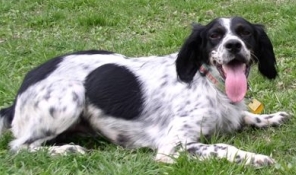
HEAT EXHAUSTION
Heat Exhaustion occurs with exercise, particularly on hot, humid days. The symptoms are similar to those of heat stroke, but may not be associated with an elevation in body temperature, as is the case with heat stroke.
Dogs more at risk are dogs with short, flattened noses, such as Boxers, Bulldogs, Boston Terriers, Lhasa Apsos, Shih Tzus, Pekinese, etc. Also at risk are dogs with heavy coats, which retain heat, making warm temperatures even more uncomfortable. At highest risk are dogs with heart or respiratory troubles, dogs who are obese, very young, or very elderly.
HEAT EXHAUSTION SYMPTOMS INCLUDE:
*Normal or slightly elevated body temperature (37-39)
*Heavy panting
*Huffing and puffing or gasping
*Dazed mental status: An anxious, vacant, or staring expression
*Drooling, or frothing
*Weaving when walking (dizziness)
*Muscle weakness
*Dog lies down or collapses and cannot get up
*Vomiting or retching
*Muscle cramps (seizure-like tremors)
*Anxiety or agitation
*Abnormally rapid heartbeat and rapid breathing
Depending on the seriousness of the situation, these are the steps a guardian should take if they feel their dog is suffering from heat exhaustion:
1) Move the dog out of the sun and into the shade or into an air-conditioned building or car; if this is not possible put a large umbrella over them to provide shade.
2) Give the dog frequent small amounts of water to drink; DO NOT allow the dog to drink copious amounts.
3) Rinse the dog off with cool water, paying special attention to ears, groin, armpits, & belly.
4) Place the dog in front of a fan while still damp, or use a newspaper or towel to fan the dog (taking care not to frighten them by flapping too close to their face).
5) Place ice bags wrapped in cloth around the dog’s neck and against the groin area for rapid blood cooling.
6) Take the dog to the NEAREST veterinarian or veterinary emergency clinic. Do NOT cover your dog, even with a cold towel. A towel will prevent the heat
from escaping. Keep wiping the ears, groin, armpits, & belly with a wet cold washcloth.
HEAT STROKE SYMPTOMS INCLUDE: all symptoms of heat exhaustion, plus:
*A very high body temperature (organ damage begins to occur at body temperatures over 41 degrees Celcius)
*A rapid and erratic heartbeat/pulse
*Rapid breathing, or struggling for breath
*Exaggerated panting, or the sudden stopping of panting
*Increased, excessive, loud, heaving, irregular panting or the sudden stopping of panting
*Frothing at the mouth
*Dark red gums
*Barking or whining
*Loss of consciousness
*Shaking or seizures
Other signs of heat stroke can include some or all of the following:
*Dry mouth and nose
*Lack of urine production
*Weakness and muscle tremors
*Dryness and redness progressing to dull grayish-pink or purplish-blue) of the inside of the tongue, mouth, lips and gums
*Glazed eyes and/or dilated pupils
*Vomiting and/or diarrhea
HEAT STROKE IS AN EMERGENCY REQUIRING INTESIVE VETERINARY CARE INCLUDING RAPID INFUSION OF INTRAVENOUS FLUIDS.
AFTERCARE: Dogs with heat exhaustion to moderate heat stroke often recover without complicating health problems. Severe heat stroke can cause organ damage that may need ongoing care such as a special diet prescribed by your veterinarian. Dogs who suffer from heat stroke once increase their risk of getting it again and steps must be taken to prevent it on hot, humid days.
HOW TO CARE FOR YOUR DOG IN HOT WEATHER:
*Do not leave your dog in the car. EVER.
*Walk your dog in the early morning or evening when it is cooler.
*Provide constant access to fresh water.
*If possible, keep your dog indoors in a cool, well ventilated or air-conditioned part of the house.
*Air conditioning is one of the best ways to keep a dog cool, but is not always dependable. To provide a cooler environment, freeze water in plastic soda bottles, then wrap them in towels or a tube sock. Place them on the floor for the dog to lie on. You may also place ice and a small amount of water in several resealable food storage bags, cover them with a towel, and place them on the floor for your dog to lie on.
*If you do not have air-conditioning, and your dog cannot seek out a cool spot like a basement, place a wet towel on the floor, (or use ice bags as explained above), or purchase a cooling pad for your dog to lie on.
*You may want to invest in a “Cooling Jacket” for your pet to wear in hot weather or in unavoidable situations where your dog must be in hot temperatures. If your pet is outside during the day, consider investing in a Cooler Mat or a Cooling Bandana. You can easily make your own with an old pillowcase and absorbent gel beads.
*Do not muzzle your dog when left alone (except for basket/cage muzzles that allow panting and drinking)
*Don not confine your dog without shade or in an area with only concrete or asphalt surfaces.
*If your dog lives outside, make sure there is plenty of fresh, water, and that the doghouse or dog bed is in the shade. For an outside dog, an automatic waterer is a good way to provide clean fresh water.
*If your dog must be outside on a leash or cable, be sure it is long enough for them to reach full shade and water.
*After walks, or when your dog seems warm, wipe down the fur with a washcloth or towel rinsed in lukewarm water. Wring the cloth out just enough to keep it from dripping, and soak down the fur of the head, earflaps, around the neck, belly and groin, and on the tops and bottoms of the feet.
*Keep pets with breathing problems indoors.
*Wetting down your dog with cool water or allowing him/her to swim can also help maintain a normal body temperature.
*Do not leave your dog in the car. EVER.













